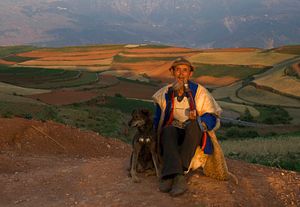Located in the northeast of Kunming, Yunnan province, southwest China, Dongchuan is a rural area in the Wumeng mountains. Dongchuan, which means “palette,” is a valley of colors. Spanning 50 kilometers around the village of Huashitou in Xintian township, about 2400 meters above sea level, are rolling mountains where fiery red soil with a variety of crops and ever changing light could easily be mistaken as a Van Gogh. The iron oxide in the soil has developed an extraordinarily reddish soil. The cultivation of golden wheat, emerald barley, white potato flowers and pink buckwheat produces a magnificent landscape, a stunning mix of geometric designs and colors.
Though Dongchuan is often referred to as the color palette of the gods, it is actually a wonderful creation of the farmers. Stones in the soil prevent croplands from retaining water. So farmers plant drought-resistant crops. The plots allotted to each family are scattered across the land – while one plants potatoes, another cultivates wheat. This random allotment lends a stunning, multicolor beauty to the land. The farmers sustain the fragile ecosystem by opting for traditional means of power generation with wind turbines that dot the undulating landscape of Dongchuan. And to make the most of a land that is hardly ideal for farming, the people of Dongchuna have resorted to plasticulture – an innovative method of boosting the land’s productivity in which plastic tunnels are painstakingly created over the croplands to retain moisture, control temperature, and keep out weeds and insects.












































